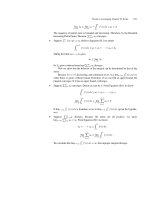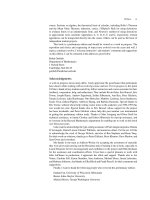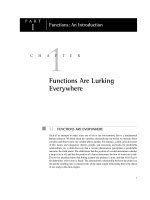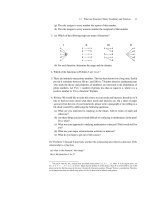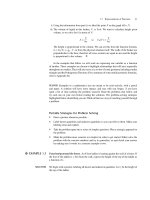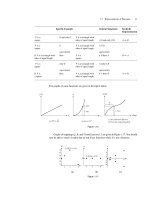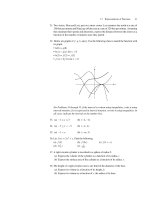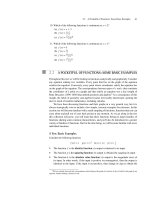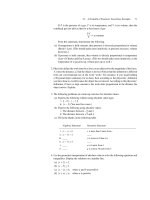Calculus: An Integrated Approach to Functions and their Rates of Change, Preliminary Edition Part 4 doc
Bạn đang xem bản rút gọn của tài liệu. Xem và tải ngay bản đầy đủ của tài liệu tại đây (260.98 KB, 10 trang )
1.2 What Are Functions? Basic Vocabulary and Notation 11
(g) The rule assigns to every number the square of that number.
(h) The rule assigns to every nonzero number the reciprocal of that number.
3. (a) Which of the following maps are maps of functions?
I II III IV
aaaaaa
bbbbb
cc c x b b c c
dddccd
eezde
(b) For each function, determine the range and the domain.
4. Which of the functions in Problem 3 are 1-to-1?
5. There are infinitely many prime numbers. This has been known for a long time; Euclid
proved it sometime between 300 b.c. and 200 b.c.
6
Number theorists (mathematicians
who study the theory and properties of numbers) are interested in the distribution of
prime numbers. Let P (n) = number of primes less than or equal to n, where n is a
positive number. Is P (n) a function? Explain.
6. Writing: We would like to tailor this course to your needs and interests; therefore we’d
like to find out more about what these needs and interests are. On a sheet of paper
separate from the rest of your homework, please write a paragraph or two telling us a
bit about yourself by addressing the following questions.
(a) What are you interested in studying in the future, both in terms of math and
otherwise?
(b) Are there things you have found difficult or confusing in mathematics in the past?
If so, what?
(c) What was your approach to studying mathematics in the past? Did it work well for
you?
(d) What are your major extracurricular activities or interests?
(e) What do you hope to get out of this course?
For Problems 7 through 9 determine whether the relationship described is a function. If the
relationship is a function,
(a) what is the domain? the range?
(b) is the function 1-to-1?
6
The proof went like this: Assume there are finitely many primes: 2, 3, 5, 7 ,N, where N is the largest prime. Let
M = 2 · 3 · 5 · 7 · N +1; i.e., let M be 1 bigger than the product of all the primes. Then M is not divisible by any of the
primes on the list. But that means the list doesn’t include all of the prime numbers. Whoops! We have a contradiction. Therefore,
our assumption that there are finitely many primes is false. So there must be infinitely many primes.
12 CHAPTER 1 Functions Are Lurking Everywhere
7. Input Output 8. Input Output 9. Input Output
02
√
22
√
20
13
√
33 2
√
20
22
√
55 3
√
20
33
√
66 4
√
20
42
10. Express each of the following rules for obtaining the output of a function using func-
tional notation.
(a) Square the input, add 3, and take the square root of the result.
(b) Double the input, then add 7.
(c) Take half of 3 less than the input.
(d) Increase the input by 10, then cube the result.
11. Let C be a circle of radius 1 and let A(n) be the area of a regular n-gon inscribed in
the circle. For instance, A(3) is the area of an equilateral triangle inscribed in circle
C, A(4) is the area of a square inscribed in circle C, and A(5) is the area of a regular
pentagon inscribed in circle C. (A polygon inscribed in a circle has all its vertices lying
on the circle. A regular polygon is a polygon whose sides are all of equal length and
whose angles are all of equal measure.)
(a) Find A(4).
(b) Is A(n) a function? If it is, answer the questions that follow.
(c) What is the natural domain of A(n)?
(d) As n increases, do you think that A(n) increases, or decreases? This is hard to
justify rigorously, but what does your intuition tell you?
(e) Will A(n) increase without bound as n increases, or is there a lid above which the
values of A(n) will never go? If there is such a lid (called an upper bound) give
one. What is the smallest lid possible? Rigorous justification is not requested.
12. Some friends are taking a long car trip. They are traveling east on Route 66 from
Flagstaff, Arizona, through New Mexico and Texas and into Oklahoma.
Let f be the function that gives the number of miles traveled t hours into the trip, where
t = 0 denotes the beginning of the trip. For instance, f(7)is the mileage 7 hours into
the trip. If the travelers set an odometer to zero at the start of the trip, the output of f
would be the reading on the odometer.
Let g be the function that gives the car’s speed t hours into the trip, where t = 0 denotes
the beginning of the trip. For instance, g(7) is the car’s speed 7 hours into the trip. The
output of g corresponds to the speedometer reading.
Suppose they pass a sign that reads “entering Gallup, New Mexico,” h hours into
the trip.
(a) Write the following expressions using functional notation wherever appropriate.
i. The car’s speed 1 hour before reaching Gallup
ii. 10 miles per hour slower than the speed of the car entering Gallup
iii. Half the time it took to reach Gallup
1.2 What Are Functions? Basic Vocabulary and Notation 13
iv. Their speed 6 hours after reaching Gallup
v. The distance traveled in the first 2 hours of the trip
vi. The distance traveled in the second 2 hours of the trip
vii. Half the distance covered in the second 3 hours of travel
viii. The average speed in the first 5 hours of travel (Average speed is computed
by dividing the distance traveled by the time elapsed.)
ix. The average speed between hour 6 of the trip and hour 12 of the trip
(b) Interpret the following in words.
i. f(h+2)
ii.
1
2
f (h)
iii. f(
h
2
)
iv. f(h−2)
v. f (h) − 2
vi. f (h) + 2
vii. g(h + 2)
viii. g(h) + 2
ix. g(h) − 2
x.
1
2
g(h)
xi.
1
2
g(h − 1)
13. Let C(w) be the amount (in dollars) it costs you to mail your grandmother a first-
class package weighing w ounces. Suppose you just mailed her a birthday present that
weighed A ounces. Describe in words the practical meaning of each of the following
expressions.
(a) C(A) (b) C(2A) (c) 2C(A) (d) C(A +1) (e) C(A) + 1
14. If f(x)=
1
x+1
, find the following. Simplify your answer where possible.
(a) f(0) (b) f(3) (c) f(−
1
4
) (d) f(b) (e) f(b−1)
(f) f(b+3) (g) [f(7)]
2
(h) f(b
2
) (i) [f(b)]
2
15. If g(x) =
√
x
2
+4
2
, find the following. Simplify your answer where possible.
(a) g(0) (b) g(2) (c) g(
√
5) (d) g
1
√
2
(e) −g(3t) (f) g(
√
t − 4)
16. If h(x) =
x
2
1−2x
, find
(a) h(0) (b) h(3) (c) h(p + 1) (d) h(3p) (e) 2h(3p) (f)
1
h(2p)
17. If j(x)=3x
2
−2x +1, find the following. Simplify your answer where possible.
(a) j(0) (b) j(1) (c) j(−1) (d) j(−x) (e) j(x +2) (f ) 3j(x)
(g) j(3x)
18. If P(x)=5−2x,find the following.
(a) P(1) (b) P(−1) (c) P(2W) (d) P(2W +1) (e) P(W
2
)
(f) [P(W)]
2
(g) P(W
2
+1)
14 CHAPTER 1 Functions Are Lurking Everywhere
In Problems 19 through 21
(a) find the value of the function at x = 0, x = 1, and x =−1.
(b) find all x such that the value of the function is (i) 0, (ii) 1, and (iii) −1.
19. f(x)=
3x+5
2
20. g(x) =x
2
−1
21. h(x) =
x
2
+2x
3x+2
(For a review of quadratic equations, refer to the Algebra Appendix.)
For each function in Problems 22 through 27, determine the largest possible domain.
22. (a) f(x)=
1
5x+10
(b) g(x) =
√
5x + 10
23. (a) f(x)=
1
x
2
−1
(b) g(x) =
√
x
2
− 1
For part (b), factor the quadratic. The product must be positive. For more assistance,
refer to the Algebra Appendix.
24. (a) f(x)=
3
x
2
+3x−4
(b) g(x) =
√
x
2
+ 3x − 4
Factoring will help clarify the solution.
25. (a) f(x)=
1
x
2
+2x+1
(b) g(x) =
√
x
2
+ 2x + 1
Factoring will help clarify the solution.
26. (a) f(x)=
1
x+2
−
1
x−1
(b) g(x) =
√
x + 2 −
√
x − 1
27. (a) f(x)=
3
x
+
2
3−x
−
x
2x+2
(b) g(x) =
√
x + 2
√
3 − x
28. The volume of a sphere and the surface area of a sphere are both functions of the sphere’s
radius. The volume function is given by V(r)=
4
3
πr
3
and the surface area function is
given by S(r) =4πr
2
.
(a) If the radius of a sphere is doubled, by what factor is the volume multiplied? The
surface area?
(b) Which results in a larger increase in surface area: increasing the radius of a sphere
by 1 unit or increasing the surface area by 12 units? Does the answer depend upon
the original radius of the sphere? Explain your reasoning completely. (It may be
useful to check your answer in a specific case as a spot check for errors.)
(c) In order to double the surface area of the sphere, by what factor must the radius
be multiplied?
(d) In order to double the volume of the sphere, by what factor must the radius be
multiplied?
29. Let A = A(S) be the area function for a square of side S. A takes as input the length S
of the side of a square and gives as output the area of the square.
(a) Find the following.
i. A(4) ii. A(W ) iii. A(
√
2 + 3) iv. A(4 + h) v. A(x − 1)
1.3 Representations of Functions 15
(b) Suppose that S is bigger than 1. Which is larger, A(S − 1) or A(S) − 1? (Does the
answer depend on the size of S? If so, how?)
(c) Explain in words the difference between A(S − 1) and A(S) − 1. Which one of
the expressions corresponds to the shaded area in the accompanying figure? What
area corresponds to the other expression?
S – 1
S – 1
S
1.3 REPRESENTATIONS OF FUNCTIONS
Presenting a Function Using a Table
◆
EXAMPLE 1.3 Let N be the function that assigns to each year the number of applicants to Harvard College
for the fall of that year. N is a function, because each input completely determines the
output. For a restricted domain, this function can be expressed in the form of a table.
Year Number of Applicants
1999 18,164
1998 16,818
1997 16,597
1996 18,183
1995 17,852
1994 15,261
1993 13,865
1992 13,029
1991 12,589
1990 12,190
1989 12,843
We may not be able to express this function in the form of an equation or formula that will
correctly predict future numbers. In fact, we cannot determine the output associated with
an input of 2020 or 2021 at the present time. Nevertheless, N is a function because each
year a certain number of students apply. ◆
16 CHAPTER 1 Functions Are Lurking Everywhere
Presenting a Function in Words; Presenting a Function Using a Formula
◆
EXAMPLE 1.4 Tariffs. Consider the following two schemes of tariffs on the sale of automobiles. State 1
collects a fixed tax of $500 on every car sold; state 2 levies a 4% tax on the list price of
every car sold. Let x be the list price of a car and let f and g be the tax functions in states
1 and 2, respectively. We can describe the input-output relationship of the functions f and
g using formulas.
f(x)= 500 g(x) = 0.04x
The graphs of the functions f and g are given below.
What is the significance of the x-coordinate of the point of intersection of the lines?
tax
cost of car
500 f
g
Figure 1.4
REMARKS
i. The function f is a constant function, assigning the output 500 to every acceptable
input. When thinking about functions it is handy to have a little stash of specific
functions at your fingertips to contemplate as case studies. Stash the set of constant
functions in your mind for future reference.
ii. g(x) = 0.04x tells us that the tax in state 2 is 4% of the list price of the car.
We translate “A%ofB”as
A
100
· B.
If the tax is kx, where x is the price and k is a constant, we say that the tax is directly
proportional to the price, with proportionality constant k.
We translate “C is proportional to D” as C = kD for some constant k.
The idea of proportionality is important; you will see it come up repeatedly in the
physical and biological sciences and in economics.
iii. The function g is 1-to-1 because every output is used only once. The function f is not
1-to-1 because one output corresponds to more than one input (infinitely many in this
case).
◆
Chances are that many of the functions you have seen so far in your mathematics courses
have been given by formulas. This is the type of function with which you are probably most
1.3 Representations of Functions 17
familiar.
7
For example, because a circle’s area is uniquely determined by its radius,
8
we can
say that the area A of a circle is a function of the radius r: A = πr
2
. In functional notation
we can write A =f(r),where f(r)=πr
2
; we read this as “A equals f of r.” On the other
hand, we might decide to name our area function “A” instead of “f ,” in which case we
could write A = A(r) =πr
2
.To indicate that a circle of radius 3 has an area of 9π we write
A(3) =9π;9πis the value of the function at 3. When we read A = A(r) we think “the area
is uniquely determined by the radius.”
NOTE In the example above we’ve let “A” denote both the area of the circle and the
function whose input is the radius of a circle and whose output is the area. Recall that
a “T” sign may sometimes be a landmark indicating a subway station and other times
may indicate a bus stop; we can discern the meaning by the context. Similarly, A(r) may
sometimes be used to indicate the area function and other times be used to indicate the
output associated by the area function with the input r;wefigure out which is implied by
the context.
Domain and Range
When a function is modeling a real-life situation, the conditions of the situation determine
the appropriate domain. Such is the case for the area function where the domain (the set
of all possible radii) is the set of positive numbers. When a function is simply given by a
formula without context then, unless otherwise specified, the domain is the largest set of
inputs for which the function is defined. We’ll refer to this as the natural domain of the
function.
When looking for the natural domain of a function, keep in mind the following.
Division by zero is undefined;
h(x)
g(x)
is undefined wherever g(x) =0.
9
The square root is undefined for negative numbers;
√
g(x) is undefined for g(x) < 0.
Equality of Functions. The functions f and g are equal if:
f and g have the same domain, and
f(x)=g(x) for every x in the domain.
For example, the functions f(x)=
x
2
−x
x
and g(x) = x −1 are not equal; the domain of g
is all real numbers, while the domain of f does not include x = 0.
◆
EXAMPLE 1.5 Suppose f(x)=
√
x+1
x−2
. Find the natural domain of f .
SOLUTION In order for
√
x +1tobedefined, we need x + 1 ≥ 0. Therefore, x ≥−1.
7
In fact, it was not until the nineteenth century that the mathematician Lejeune Dirichlet formulated the modern definition of
a function as an input-output mapping such as we gave in the previous section. (Eli Maor, e: The Story of a Number, Princeton
University Press, 1994.) Earlier mathematicians, including such giants as Euler and Johann Bernoulli, thought of functions only
as formulas, just as you perhaps did before starting this chapter. (Howard Eves, An Introduction to the History of Mathematics,
6th Edition, Saunders College Publishers, 1990.)
8
For a review of geometric formulas, see Appendix B: Geometric Formulas. Do you confuse the formulas for circumference
and area? Circumference is one-dimensional; the circumference formula involves an r to the first power: C(r) =2πr. Area is
two-dimensional; the area formula involves an r
2
: A(r) = πr
2
.
9
What does it mean when we write
A
B
=C? It means A =C · B. Can you see why
A
0
is undefined? Suppose A =0 and
A
0
=C.
But C · 0 = 0 and A = 0, giving a contradiction. Suppose A = 0. Then 0 = C · 0 regardless of the value of C, so we still can’t
define division by zero.
18 CHAPTER 1 Functions Are Lurking Everywhere
The denominator of the fraction cannot be zero, so x = 2.
The domain of f is {x: −1 ≤ x<2orx>2}.
10
We can express this using interval notation by writing
x is in [−1, 2) or (2, ∞).
◆
Interval Notation. Interval notation is useful for describing an interval on the number
line.
[2, 5] is the set of all numbers between 2 and 5 including both 2 and 5. We can write
x ∈ [2, 5], where the symbol “∈” is read “in”; this expression is equivalent to 2 ≤ x ≤ 5.
[2, 5] is called a closed interval because the numbers 2 and 5 are included in the interval.
We indicate this on a number line by using filled circles at 2 and 5.
25
(2, 5) denotes the set of all numbers greater than 2 and less than 5 but excluding 2 and
5 themselves. x ∈ (2, 5) is equivalent to 2 <x<5. (2, 5) is called an open interval
because neither of its endpoints are included in the interval. We indicate this on a
number line by using open circles at 2 and 5.
25
Notice that there is neither a smallest number nor a largest number in the interval (2, 5).
The number 5 is an upper bound (ceiling) for the interval; in fact, it is the smallest upper
bound. The number 2 is a lower bound (floor) for the interval; it is the greatest lower bound.
(0, ∞) is the set of all positive real numbers.
11
Writing x ∈ (0, ∞) is equivalent to
writing x>0.The symbol “∞” is read “infinity” and denotes the absence of an upper
bound for this interval. “∞” is a symbol, not a number!
[0, ∞) denotes the set of all nonnegative numbers.
(−∞, ∞) denotes the set of all real numbers.
We can combine “[” and “(” to include or exclude the endpoints of an interval as
appropriate. However, we never use a square bracket “]” with the symbol for infinity, ∞.
It is very important to keep in mind that ∞ is not a number.
12
Suppose that y is a function of x and that we would like to present this function using a
formula. If we have an equation relating x and y, then solving this equation unambiguously
for y in terms of x allows us to express y as a function of x.
For example, suppose that a person has $2000 to invest. He decides to spend a certain
amount on slow-growth stocks, twice that amount on riskier but potentially high-return
10
Braces, {}, are used because this is a set. The colon, :, is read “such that.” The expression x: is read aloud as “the set of x
such that ”
11
Real numbers will be discussed in Chapter 2.
12
Because ∞ is not a number it cannot be treated like a number: You can’t put it on a number line, and you can’t add, subtract,
multiply, or divide with ∞ as if it were a number.
1.3 Representations of Functions 19
stocks, and the rest on bonds. Let s be the amount he puts into slow-growth stocks, 2s be
the amount he puts into riskier stocks, and b be the amount he puts into bonds. Then
s +2s + b = 2000.
We can solve this equation for b unambiguously in terms of s; therefore b is a function of s:
b = f(s)=2000 − 3s.
We can solve this equation for s unambiguously in terms of b; therefore s is a function
of b:
s =g(b) =
2000 −b
3
.
On the other hand, suppose that we are interested in a point on the rim of a 13-inch
bicycle tire. We choose the hub of the wheel to be the origin of our coordinate system,
letting v denote the vertical height of the point (v is positive when the point is above the
hub and negative when it is below) and h denote the horizontal coordinate of the point. The
distance between the hub, located at (0, 0), and the point on the rim, located at (h, v), is 13;
therefore,
v
2
+ h
2
= (13)
2
.
v
h
13
(h,v)
v
13
h
Figure 1.5
We cannot solve this equation unambiguously for either variable. For instance, v =
±
√
169 − h
2
,sov=
√
169 − h
2
or v =−
√
169 − h
2
. There is ambiguity here. Know-
ing h does not uniquely determine v. In this example v is not a function of h. Similarly, h
is not a function of v.
In the preceding example we used the distance formula. This formula will be useful to
us, so we review it here. The distance between the points (x
1
, y
1
) and (x
2
, y
2
) in the plane
is given by
d =
(x)
2
+ (y)
2
=
(x
2
− x
1
)
2
+ (y
2
− y
1
)
2
,
where the capital Greek letter (read: delta) is used as a shorthand for the words “change
in.” This is a direct consequence of the Pythagorean Theorem.
20 CHAPTER 1 Functions Are Lurking Everywhere
c
b
a
y
Pythagorean Theorem:
a
2
+ b
2
= c
2
x
d
Change in y:
y
2
– y
1
Change in x: x
2
– x
1
(x
2
,
y
2
)
(x
1
,
y
1
)
Figure 1.6
◆
EXAMPLE 1.6 Bottle calibration. When calibrating a bottle, the input is the volume of liquid poured into
that bottle. For a particular bottle the calibration function assigns to each volume a unique
height; this is the function’s output. We can give the calibration function a name, like C.If
we want to specify that we are referring to the calibration function for a beaker we might
even name the function C
b
, which can be read as “C sub b.” The calibration function for
a given bottle assigns to each volume a unique height; therefore, we say that “height is a
function of volume.”
Consider the calibrating function C
b
for a cylindrical beaker with radius 3 inches and
height 7 inches.
i. Find the domain and range of the function.
ii. Find the coordinates of the point marked “P .”
iii. Find a formula for the function. Is height directly proportional to volume?
height
P
volume
3"
7"
C
b
volume → height
Figure 1.7
SOLUTION i. The domain is the set of all acceptable volumes: [0, B], where B is the volume of the
full beaker. The volume of a cylinder of height h and radius r is the product of the height
and the area of the disk that is its base, i.e. πr
2
h.Since the radius is 3 inches, the volume
is 9πh cubic inches. (Notice that the height varies with the amount of liquid but the
radius does not.) The maximum height of liquid that the beaker can hold is 7 inches,
so the maximum volume is π(3
2
)(7) = 63π cubic inches. Therefore, the domain is
[0, 63π]. The range, the set of all possible heights, is [0, 7].
